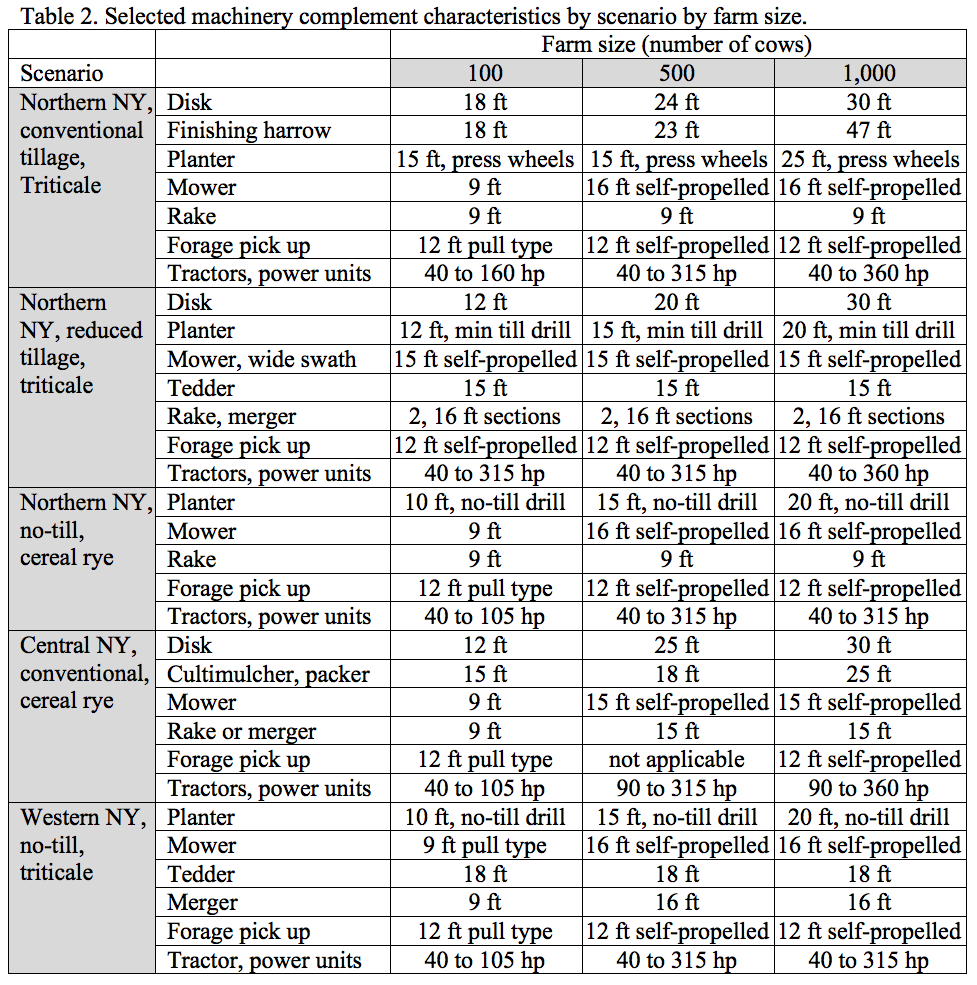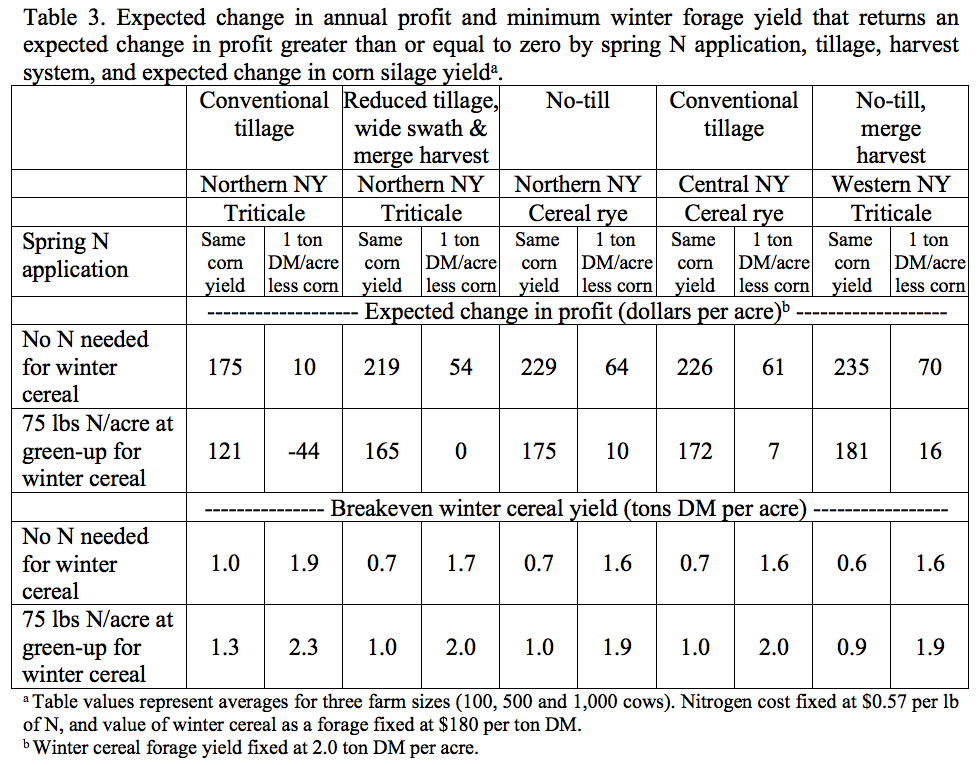Hanchar1, J.J., Q.M. Ketterings2, T. Kilcer2,3, J. Miller4, Kitty O’Neil5,M. Hunter6, B. Verbeten1, S.N. Swink2, and K.J. Czymmek7
1Northwest New York Dairy, Livestock, and Field Crops Program, Cornell University, 2Nutrient Management Spear Program, Department of Animal Science, Cornell University, Ithaca, New York, 3Advanced Ag Systems, 4Cornell Cooperative Extension of Oneida County, 5Cornell Cooperative Extension of St Lawrence, Franklin, Clinton, Essex Counties, 6Cornell Cooperative Extension of Jefferson and Lewis County, and 7PRO-DAIRY, Cornell University
Weather extremes in 2012 and 2013 impacted corn silage and hay yields for many dairy farms in New York, prompting a growing interest in double cropping of winter cereals for harvest as high quality forage in the spring. From 2012 to 2014, forage yields were measured for 19 cereal rye fields and 44 triticale fields in New York where the winter cereal for forage followed corn. Yields averaged 1.62 and 2.18 tons of dry matter (DM) per acre for cereal rye and triticale, respectively, and 71% of all fields in the study exceeded 1.5 tons DM/acre (Ketterings et al., 2014). To learn from farmers’ experiences, 30 New York farm managers that had grown winter cereals for forage were interviewed. Surveyed farmers planted, on average, 8% of their tillable acres to winter cereals with the intent to harvest as forage. Triticale was most frequently used (70%), typically seeded with a drill (57%). Farmers identified timely fall seeding as the biggest challenge with double cropping of winter cereals. Despite challenges and production questions, 83% of the surveyed farmers planned to continue to grow double crops.
Examining the Economics of Double Cropped Winter Cereals for Forage
The economic analysis sought to answer three questions: (1) What are the costs of production associated with double cropped winter cereals for forage following corn silage?; (2) What are the expected changes in profit associated with double cropping?; and (3) What yield levels ensure that adoption of a double cropped winter cereal will be a profitable change? For this analysis, five general scenarios were defined (Table 1).
Producers helped to describe the machinery complement, including size of tillage, planting and harvesting machinery, tractors, and self-propelled units for three dairy farm sizes: 100, 500 and 1,000 cows (Table 2). Scenarios reflected cultural practices, hours per acre by task, input use, and other factors typical or recommended for the region. Cost concepts, including variable and fixed costs, machinery costs based upon hours of use per acre, and others, were used to estimate costs of production for different scenarios. Lazarus (2014) provided machinery ownership and operating cost per hour estimates. All analyses reflect 2014 price levels.
Partial budgeting was used to estimate changes in profit associated with the double crops versus no winter crop, where profit equaled value of production, income minus the costs of inputs used in production. A partial budget analysis answers four questions: (1) What increases in value of production are expected?; (2) What decreases in costs are expected?; (3) What decreases in value of production are expected?; and (4) What increases in costs are expected? The first two items combine to increase profit, while the third and fourth items combine to decrease profit.
Costs and changes in profit resulting from key variable alternatives were estimated. For costs of production estimates, N application at spring green-up was set at 0 or 75 pounds per acre (two scenarios, based on early research), while expected winter cereal forage yield was 1, 1.5, 2, 3, or 3.5 tons DM per acre (five scenarios, reflecting yield distribution realistic for New York). To estimate the sensitivity of expected changes in profit, we used a forage value of $130, $180, $200, or $220 per ton DM (four scenarios), and defined expected change in corn silage yield following the winter cereal crop in the rotation as 0 (no decline), -0.25, or -1 ton DM per acre (three scenarios).
Costs of Production
Costs of production per ton of winter cereal DM varied by scenario and by other key factors, including expected winter cereal yield and N needs for the winter cereal. For scenarios where the winter forage averaged 2 ton DM per acre without the need for extra N at green-up, costs of production estimates averaged $94 per ton DM and ranged from $83 for no-till in Northern NY to $118 per ton DM for conventional tillage scenarios also in Northern NY. When 75 lbs of N per acre were needed to obtain the same 2 tons DM/acre winter forage yield, costs of production estimates averaged $122 per ton DM and ranged from $111 for no-till in Northern NY to $145 per ton DM for Northern NY conventional tillage scenarios.
Expected Changes in Profit and Breakeven Yields
Expected changes in income included the value of production assigned to the winter cereal harvested as forage and expected change in value of corn silage production where appropriate. Expected increases in costs included labor; machinery repairs and maintenance; fuel, oil and grease; fertilizer where appropriate; seeds; spray and other crop expenses. The analyses also reflect depreciation, but only when it was considered to be use-related, that is, when use affects the expected years owned and/or expected salvage value. Expected changes in profit averaged across the three farm sizes varied by scenario and by other key factors (Table 3).
Where 75 lbs of N was needed at green-up to generate 2 tons of DM per acre and a 1 ton DM per acre yield decline occurred for the corn seeded after the winter cereals due to a delayed planting date, expected changes in profit ranged from -$44 to +$16 per acre for the Northern NY conventional and Western NY no-till scenarios, respectively, and averaged -$2 per acre across all scenarios. Where corn yield deceased by 1 ton DM per acre and 75 lbs N per acre was needed at green-up for the winter cereal, the break-even winter forage yields averaged 2 tons DM per acre, and ranged from 2.3 to 1.9 tons DM per acre for the NNY conventional and the two no-till scenarios, respectively (Table 3). If in the same scenario, corn silage yield was not impacted, the break-even winter forage yield averaged 1 ton DM per acre. This was further reduced to 0.7 tons of DM if no N was needed at green-up of the winter forage (Table 3).
Conclusions
Economic analyses suggest that double cropping a winter cereal for forage following corn silage has the potential to be an economically attractive, beneficial change in practice for dairy farms in NY. This includes double cropping’s role in successfully managing risks related to meeting forage needs of the herd over time. Costs of production analyses suggest that double cropped winter cereals likely compare favorably to costs and/or values of alternative forages over a range of expected winter cereal yields. Partial budget analyses suggest that adoption of double cropped winter cereals as forages could be an economically beneficial change in practice for dairy farms (expected changes in profit exceed zero over a range of key factors). Break-even analyses suggest that producers have to obtain yields around 2 tons DM per acre to ensure that a double cropped winter cereal’s expected benefits are greater than or equal to expected changes in costs under the most demanding, least favorable set of assumptions (i.e., 75 lbs N/acre at green-up and a corn silage yield reduction of 1 ton DM per acre). Results are sensitive to a number of factors including expected winter cereal yield, expected value of forage, spring N addition needed, expected effect on corn silage yield and others.
References
Ketterings, Q.M., S. Ort, S.N. Swink, G. Godwin, T. Kilcer, J. Miller, W. Verbeten, and K.J. Czymmek (2014). Winter cereals as double crops in corn rotations on New York dairy farms. What’s Cropping Up? 25(3): 31-33. Accessible at: https://blogs.cornell.edu/whatscroppingup/2015/06/16/winter-cereals-as-double-crops-in-corn-rotations-on-new-york-dairy-farms/.
Lazarus, W.F. (2014). Machinery Cost Estimates. University of Minnesota, Extension. Accessible at: http://wlazarus.cfans.umn.edu/william-lazarus-spreadsheet-decision-tools/.
Acknowledgments
 Funding sources included the Northern New York Agriculture Development Program (NNYADP), a USDA-NRCS Conservation Innovation Grant, Federal Formula Funds, and Northeast Sustainable Agriculture Research and Education (NESARE). For questions about the double crop project contact Quirine M. Ketterings at 607-255-3061 or qmk2@cornell.edu, and/or visit the Cornell Nutrient Management Spear Program website at: http://nmsp.cals.cornell.edu/.
Funding sources included the Northern New York Agriculture Development Program (NNYADP), a USDA-NRCS Conservation Innovation Grant, Federal Formula Funds, and Northeast Sustainable Agriculture Research and Education (NESARE). For questions about the double crop project contact Quirine M. Ketterings at 607-255-3061 or qmk2@cornell.edu, and/or visit the Cornell Nutrient Management Spear Program website at: http://nmsp.cals.cornell.edu/.




